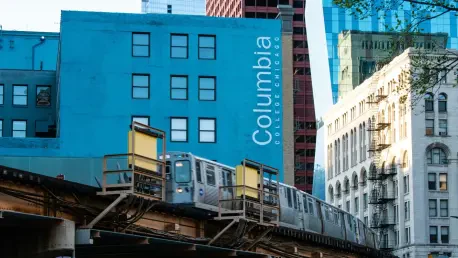In today’s challenging higher education landscape, Columbia College Chicago has been a focal point of change and adaption. Camille Faivre, an expert in education management, offers her insights on the strategies and impacts of such transformations, especially in light of recent faculty layoffs and program reductions at Columbia.
What factors led to the decision to lay off 20 full-time faculty members at Columbia College Chicago?
The decision to lay off faculty was primarily driven by the need to realign resources with areas of high student interest and market demand. Columbia College Chicago recognized that maintaining programs without sufficient enrollment wasn’t sustainable. The institution aimed to invest more effectively in programs with growth potential, ensuring that they could meet student needs within a shifting higher education landscape.
How is the college planning to invest in areas with strong student demand and growth potential?
Columbia College is focusing its investments on expanding and strengthening programs that have a proven track record of attracting students. This can include enhancing technology in classrooms, updating curriculum to meet current industry standards, and hiring faculty with specialized expertise in high-demand areas. These steps are essential to ensure that graduates are well-prepared for the job market.
Can you explain what the “initiative to reduce the college’s core education requirements” entails?
The initiative involves trimming down the general education requirements to allow students more freedom in choosing courses that directly align with their majors or interests. By reducing mandatory courses, students can tailor their educational experiences, potentially increasing engagement and satisfaction by enabling them to focus more on their professional and personal interests.
What has influenced the decision to give students more flexibility in their curriculum?
This decision was largely influenced by the changing expectations of students, who increasingly value flexibility and a personalized learning experience. Studies suggest that when students have more control over their academic paths, they are more engaged and perform better. Additionally, this change reflects industry trends that favor versatile graduates who can quickly adapt to various roles.
How are the layoffs at Columbia College Chicago impacting its general education courses?
The reduction in faculty primarily affected general education areas. Consequently, there might be a consolidation of courses or even the elimination of those with low enrollment. However, the college is likely focused on maintaining the quality and diversity of its core curriculum by streamlining offerings to ensure all essential competencies are still covered.
What has been the impact of national trends, like demographic declines and shifting attitudes towards college value, on Columbia’s enrollment?
National trends have certainly been a significant driving factor behind Columbia’s declining enrollment. Demographic shifts mean fewer high school graduates are available to fill college seats, coupled with a growing questioning of the return on investment offered by higher education. Columbia is no exception to these trends, and its enrollment strategies must adapt accordingly.
How did the 2023 adjunct faculty strike affect the college’s operations and financial health?
The adjunct faculty strike posed considerable operational challenges, likely disrupting the academic schedule and affecting faculty-student relationships. Financially, strikes can drain resources through legal fees and the need for temporary replacements. Moreover, long strikes can diminish an institution’s reputation, impacting future student enrollment and retention.
What strategies is the college employing to address its financial deficit, which surpassed $20 million between fiscal years 2021 and 2023?
Columbia is likely implementing a variety of strategies to address this deficit, including restructuring academic offerings, increasing operational efficiency, and potentially fostering partnerships with private sectors to generate additional revenue streams. These measures not only aim to stabilize finances but also to enhance the institution’s long-term sustainability.
How does Columbia College Chicago plan to stabilize its finances in response to falling enrollment?
Stabilizing finances amidst falling enrollment involves a strategic approach that includes reducing operational costs, enhancing recruitment and retention efforts, and focusing on popular programs. By optimizing resources and ensuring alignment with student interests, Columbia hopes to create a more financially viable model for the future.
Can you elaborate on how Columbia is paring down its academic offerings to address financial and enrollment challenges?
By eliminating underperforming degrees and merging programs with similar goals, Columbia is attempting to streamline its academic offerings. This strategy aims to focus resources on courses with higher student interest and potential for job market success, ultimately intending to enhance the overall value of a Columbia education.
How will the elimination of 11 degrees and the combination of nine others into existing programs affect the students?
For current students, these changes could mean alterations in their academic paths, requiring adjustments in their course selections. However, the college is likely to provide guidance and support to ensure students can transition smoothly, maintaining progress toward their degrees without compromising educational quality.
How does Columbia participate in broader education trends by reducing the core education curriculum?
By reducing core requirements, Columbia is staying in step with broader education trends emphasizing student choice and relevance. This shift reflects the growing importance of offering educational paths that match modern career demands and student aspirations, fostering an environment where personal and professional growth is prioritized.
What are the anticipated benefits for students with the curricular changes allowing more class selection in majors, minors, or outside disciplines?
The benefits include increased engagement and motivation, as students can pursue subjects aligned with their goals and interests. This freedom can enhance learning outcomes and job readiness, making students more competitive in the job market. Moreover, the changes encourage interdisciplinary learning, a valuable trait in today’s complex global economy.
What specific actions is Columbia taking to rebuild its enrollment to 8,500 students, and why is this target significant?
Columbia is likely revamping its recruitment strategies, forging new partnerships, and enhancing student life to make the college more appealing. Achieving the target of 8,500 students is significant because it represents a sustainable size that supports financial stability and allows for a full range of academic offerings while maintaining a vibrant campus community.
How does the college intend to improve its retention and graduation rates in light of these changes?
Enhancing support services, such as academic advising, career counseling, and student engagement activities, are likely part of the college’s efforts. By creating a supportive and enriching educational environment, Columbia seeks to improve retention and graduation rates, ensuring that students not only enroll but thrive and complete their education.
What does Interim President Jerry Tarrer mean by “necessary for the long-term success of our cherished college”?
This statement emphasizes the strategic nature of the changes, which, although difficult, are seen as essential for the college’s endurance and continued excellence. These actions are deemed critical to positioning Columbia for a successful future by ensuring it remains financially viable and academically robust.
Can you provide details on the financial performance of Columbia’s academic programs and how that influences decisions to offer fewer majors?
When academic programs consistently operate at a loss, it isn’t sustainable in the long term. This financial strain forces the institution to evaluate and rationalize its offerings, eliminating programs that do not attract enough students to cover costs and investing in those that are more viable.
What role do you see the business-related courses playing in Columbia’s new academic structure?
Business-related courses are likely seen as integral due to their applicability across various career paths, making them a draw for students looking for versatile and practical skills. Integrating business principles can enhance students’ readiness for the workforce, meeting both student and employer expectations in today’s economy.
What is your forecast for Columbia College Chicago’s future, given these substantial changes?
Columbia’s future will hinge on its ability to be agile and responsive to student needs and industry trends. If it successfully aligns its academic offerings with demand and enhances its value proposition, the college can stabilize and potentially prosper. The ability to innovate in its educational model and maintain a strong community connection will be key determinants of its success.









